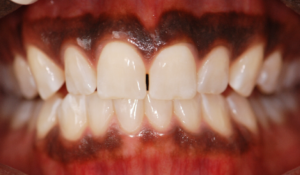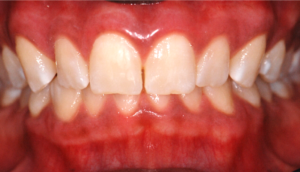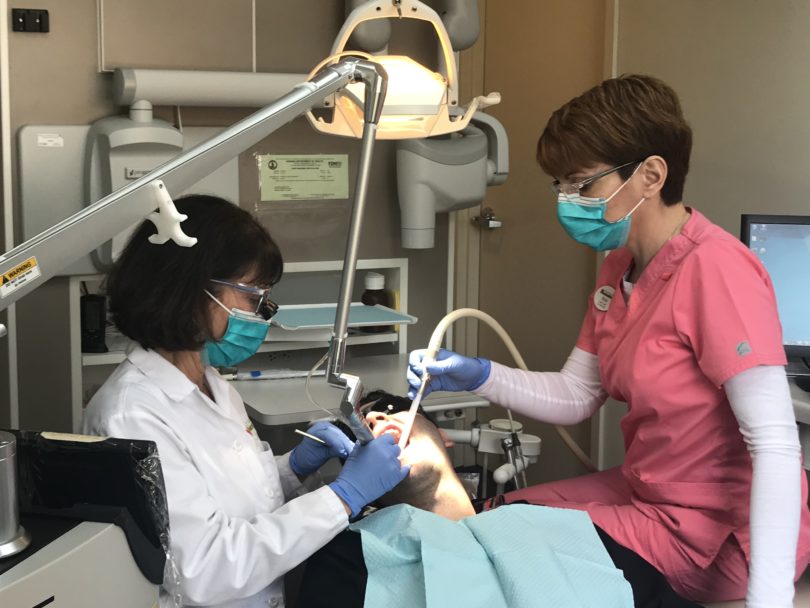The use of lasers in medicine goes back to at least the 1960s, when a dermatologist attempted to remove an unwanted tattoo. As the decades have passed, lasers have become an integral part of medicine, used by doctors for everything from removing tumors to improving vision.
In dentistry, the use of lasers has led to revolutionary changes in managing periodontal disease and treating various other oral issues.
“With the rapid advancements in dental technology, we are able to treat many conditions more conservatively and more gently,” says Dr. Lisa Marie Samaha of Port Warwick Dental Arts.
In her Newport News, Va., practice, Samaha uses a CO2 laser that uses carbon dioxide to produce energy, or in this case, light. Light from a CO2 laser is powerful enough to cut many materials, including cloth, wood and paper, but it’s also gentle enough to work on delicate gums. Samaha uses a pulsed laser with one of the lowest levels of tissue penetration, which she says is extremely safe for the patient and promotes quick healing. Local anesthesia usually isn’t needed, either.
When used on the mouth, the pulsed CO2 laser essentially vaporizes bacterial, fungal and viral lesions and can even promote regeneration of bone and gum tissue, which makes it ideal for treating periodontal disease non-surgically. It helps minimize bleeding and reduces the need for pain medication.
Using the pulsed CO2 laser, Samaha is able to:
- Provide non-surgical treatment of periodontal disease
- Treat fever blisters (herpes), canker sores and ulcers
- Remove overgrown gum tissue (which can occur from certain medications)
- Improve “gummy smiles”
- Smooth out discolorations or hereditary hyper-pigmentation of gum tissue
- Biopsy diseased tissue
- Remove hemangiomas of the lips
- Remove excess muscle attachments (“tongue ties” and “lip ties”) between teeth, under the lips or under the tongue, from infants to adults
“Whether the laser is used for smaller procedures or more advanced surgical procedures, the result is the same — a more rapid and comfortable healing process,” Samaha says.
Patients report that dental laser treatments are painless, with just a slight rubbing sensation, according to Samaha.
Terri Wilkins of Newport News went to Samaha after spending years being embarrassed about her dark and spotted gums. Not only was Samaha able to use the CO2 laser to give Wilkins the nice, pink gums she had dreamt of, but she also realized Wilkins was suffering from periodontal disease, which can cause loss of teeth in later stages, as well as medical issues throughout the body if not treated.
“I felt so ugly,” recalls Wilkins. “I had no idea that anything could be done until one day I saw pictures of someone else that Dr. Samaha had taken care of. I ran to her office!”
After treatment, Wilkins says she was in tears: “I was so happy. It has changed my whole perception of myself in such a positive way.”


The laser can be used on the littlest of patients, even newborns, to treat tongue- and lip-ties. A tongue-tie is when the band of tissue — called the frenulum — that tethers the tongue to the bottom of the mouth is too short, thick or tight, causing issues with breast-feeding, speaking, breathing, eating and even jaw development if not treated.
While other doctors might release the tongue-tie with a blade, a CO2 laser can be used in a gentle procedure that takes only seconds, Samaha says.
The laser is also remarkable in being able to treat most periodontal disease without traditional scalpel/suture surgery, says Samaha, a general dentist who has decades of training in advanced periodontal therapy. The laser is used to remove and disinfect diseased gum tissue as well as to vaporize toxins that are embedded in the soft tissue and on the root surfaces of the teeth.
Within 90 days of incorporating the CO2 laser into her periodontal disease treatment protocol in 2005, Samaha was successfully treating 90 percent of her diagnosed periodontal disease patients with the laser. As a result, she reduced surgical treatment to about 10 percent, finding that it was only needed in the most severe cases. This was a “profound, practice-altering moment” for her, she says, and she’s never looked back. In her professional seminars, she instructs in the use of the CO2 laser.
We hear from patients who have been told they need periodontal surgery,” says Samaha. “They are thrilled to learn we can almost always treat their disease non-surgically.”
Samaha’s protocol for the non-surgical treatment of periodontal disease is a multi-faceted one for which laser therapy is only a part. She trains others and is published for her protocol, which includes targeted nutrition, lifestyle habits, medical testing and DNA testing of the specific bacteria that are causing each person’s disease — essentially “personalized dentistry” for each patient.
“I stand as flesh-and-blood testimonial to Dr. Samaha’s ability to transform lives through her comprehensive, ‘whole-body’ approach to dentistry,” says Virginia Beach resident Geno Seay, who had periodontal treatment including laser use as well as partial tooth replacement. “She not only took care of my dental disease, but guided me to living a more healthy life.”



